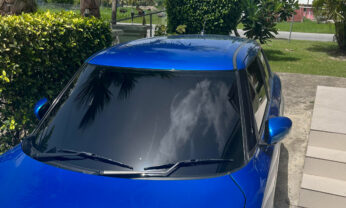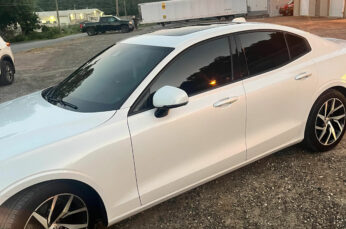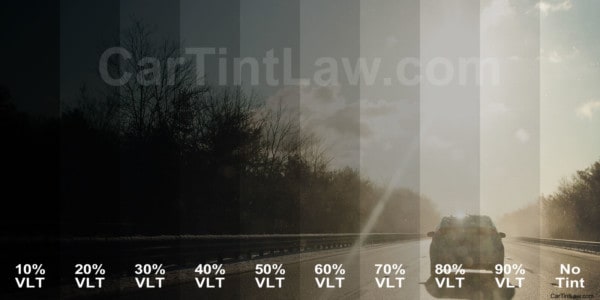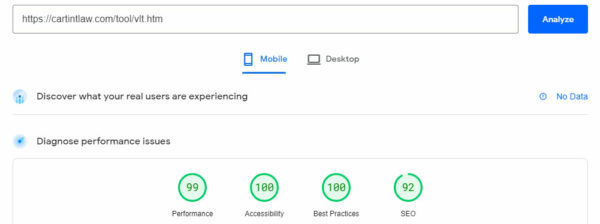When it comes to tinting your car windows there’s one important and commonly asked question: how high should you go?
We’re about to give you all the answers you have about VLT, and provide examples and previews of tint darkness levels.
What is VLT?
Tinting film darkness is measured in VLT (Visible Light Transmission). VLT numbers represent the percentage of light that comes through the windows.
This tool merely provides a preview. In most cases, tint will appear darker on your vehicle.
Here’s how U.S. laws typically define VLT:
“Light transmission” means the ratio of the amount of total light, expressed in percentages, that is allowed to pass through the sunscreening or transparent material to the amount of total light falling on the motor vehicle window.
This means that for example, 70% VLT window film will block 30% of light from coming through the window, and allow 70% to pass through.
The image below is an example tint darkness chart. It shows the effectiveness and comparison of various levels of tint. It will also help you visualize how your car tint film may appear:
In a majority of cases you do not need more than 50% VLT for the tint to be very effective, despite many vehicles using darker tint.
How dark should I go?
As you can see from our examples, using tint below 50% VLT could definitely be considered too much. Even higher light transmission percentage can be effective in blocking the sun and reducing visibility from outside.
Using high quality ceramic tint can block 99% of harmful UV rays regardless of VLT levels. Furthermore, if harmful UV rays are your only concern, you can simply install fully transparent film to block it.
Most common VLT used in cars today is 70%-85%. For majority of drivers that is more than enough to reduce glare from the sun and block most harmful UV rays. Even installing 85% VLT tinting film can make a huge difference when driving.
Are there downsides to using darkest tint levels?
Biggest downside to using low VLT tint is reduced vision of the road. This is not as impactful during daylight, but can cause visibility issues during nighttime driving. Pedestrians in dark clothing on unlit crosswalks can become difficult to notice.
The only reason to have tint below 50% VLT on front side windows is increased privacy. But during nighttime, even 70% VLT on front side windows will make it very difficult for others to see the driver from outside.
Always avoid tinting your front windshield
You always want to avoid going overboard with tinting percentages. Tint film under 50% VLT can make it very difficult to drive in low light conditions, such as tunnels or poor weather. Many drivers install this darkness even on front windshields. This is not only a bad idea because of visibility, but it’s also illegal in entire United States.

15% VLT Windshield Tint. Photo credit
Most new vehicles already come with factory-tinted windows, which is something many vehicle owners are unaware of. This can often be down to 70% VLT on front side windows. If 70% VLT is the legal limit in your state, adding any additional aftermarket tint would put you over the legal limit.

50% VLT windshield tint, 20% side windows tint. Image credit
Our Front Windshield Tinting article explores the benefits, legal issues, costs and other factors. We recommend giving it a read before you decide to tint windshields.
Keep this in mind:
- Most vehicle windows are manufactured with 8-15% window tint.
- Using quality carbon tint will massively reduce UV rays and heat inside vehicle regardless of tint darkness.
- Tint is not nearly as dark from inside the vehicle, but it still impacts your visibility, especially at night.
Choose reasonable tint darkness
You are no doubt aware how distracting the sun’s glare can be, especially if you live near the beach or frequently drive in snow. Nevertheless, you will not be driving under these conditions all the time.
Therefore, you should be reasonable when choosing your darkness levels. Although there are more benefits to tinting windows than reducing sun glare, you can always keep sunglasses in your glove box and use them when needed. Unlike window tint, sunglasses are cheaper and easier to take off when not needed.
For those who value privacy, using 50% tint on back side windows and 70% on front side windows can significantly reduce the amount of light inside your vehicle, and make it difficult to see inside. These levels are legal in most states.
Most importantly, always consult our tint laws to ensure that your window tint percentage is within legal limits in your state.
VLT Tool Embed
Due to many requests, we have made our VLT Tool available for use on other websites. You are welcome to use it on your own website with this embed code:
VLT Tool FAQs
Can I add your VLT preview to any website?
We have no restrictions and allow anyone to use this tool on their own website as long as our code remains intact. Images and code is under copyright and we do not currently allow any alterations to it. Using the tool is completely free of charge.
Will the tool work on any website?
Any website where you can paste our HTML code will show the tool. Tool does not require any other libraries, scripts or files.
Is your VLT tool responsive?
Our VLT preview tool is fully responsive and will fit any website, and will work on mobile devices too. Maximum width is 1040 pixels. Recommended minimum size is 500×260 pixels.
Can the tool be customized?
We currently do not allow any modification and do not support customization. Tool is made to be transparent, so by simply editing background-color and max-width in our embed code you can make it fit into any screen size or design.
If you have feedback or ideas on how to further improve the tool don’t hesitate to let us know.
Does your tool invade privacy?
No personal information is being tracked, recorded or submitted. Our tool includes code which only tracks top-level domain names of websites using it, and this is only to prevent abuse and ensure high uptime. This loading count data may also be visible to our CDN provider Cloudflare which we use for improved privacy and speed. If you use our tool, you may want to update your website’s privacy policies for full transparency.
What is your tool’s uptime?
We never guarantee 100% uptime, but the VLT Tool is delivered through a CDN network to ensure 99.9% uptime and fastest possible loading time.
Are there other benefits to adding VLT tool to my website?
Visitor satisfaction is our highest priority. We have been providing tinting laws since 2013 and are always the most accurate and up to date resource.
Providing our easy to use VLT Tool to your visitors can help make your website more helpful, improve the user experience, and build additional trust with your customers.
Will your tool slow down my website?
The entire Tool including code and images is only 100 KB in size. This will have a negligible impact on your overall website loading speed.
Furthermore, our embed code includes loading=”lazy”, meaning the Tool will load delayed and only appear once it enters a browsers viewport. This ensures it does not negatively impact your website’s loading speed or Google PageSpeed scores.
In addition, the tool has been optimized with speed and accessibility in mind.
If you have further questions or concerns feel free to contact us at anytime.





